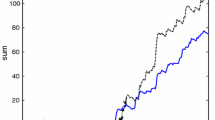Abstract
Spectrum sensing is one of the most important technologies in cognitive radio communication system. Considered the different characteristics of spectrum sensing algorithms and the computational complexity of the implementation in reality, we propose a method to process the sample signals with parallel architecture for spectrum sensing based on statistical covariance matrix. Through reasonable data grouping without affecting the performance of detection, it can take advantage of parallel computing in hardware to spectrum sensing rapidly and real-time. This parallel structure plays a great application values to reduce the complexity when implementation. This implementation method has been applied in the test bed of cognitive radio communication system which worked on the spectrum from 694MHz to 806MHz. Finally, the verification of this method has been done on the demo system based on DVB-T signal.
Access this chapter
Tax calculation will be finalised at checkout
Purchases are for personal use only
Preview
Unable to display preview. Download preview PDF.
Similar content being viewed by others
References
Brodersen, R.W., et al.: CORVUS: A Cognitive Radio Approach for Usage of Virtual no licensed Spectrum. White Paper, Dept of electrical Engineering and Computer Science University of Berkeley (July 2004)
Haykin, S.: Cognitive Radio: Brain Empowered Wireless Communication. IEEE Journal on Selected Areas in Communication 23(2), 201–220 (2005)
Zeng, Y., Liang, Y.-C.: Covariance Based Signal Detections for Cognitive Radio. In: Proc. IEEE in Dynamic Spectrum Access Networks, pp. 202–207 (2007)
Zeng, Y., Liang, Y.: Spectrum sensing algorithms for cognitive radio based on statistical covariances. IEEE Transactions on Vehicular Technology 58(4), 1804–1815 (2009)
Zeng, Y., Koh, C.L., Liang, Y.-C.: Maximum Eigenvalue Detection: Theory and Application. In: IEEE International Conference on Communications, pp. 4160–4164 (2008)
Zeng, Y., Liang, Y.-C.: Eigenvalue-based spectrum sensing algorithms for cognitive radio. IEEE Transactions on Communications 57(6), 1784–1793 (2009)
ETSI EN 300 744: Digital Video Broadcasting(DVB):Framing structure, channel coding and modulation for digital terrestrial television
Author information
Authors and Affiliations
Corresponding author
Editor information
Editors and Affiliations
Rights and permissions
Copyright information
© 2012 Springer-Verlag GmbH Berlin Heidelberg
About this chapter
Cite this chapter
Li, H., Chen, Y., Wang, Y., Li, S. (2012). Parallel Architecture Implementation of Spectrum Sensing Based on Covariance in Cognitive Radio. In: Sambath, S., Zhu, E. (eds) Frontiers in Computer Education. Advances in Intelligent and Soft Computing, vol 133. Springer, Berlin, Heidelberg. https://doi.org/10.1007/978-3-642-27552-4_95
Download citation
DOI: https://doi.org/10.1007/978-3-642-27552-4_95
Publisher Name: Springer, Berlin, Heidelberg
Print ISBN: 978-3-642-27551-7
Online ISBN: 978-3-642-27552-4
eBook Packages: EngineeringEngineering (R0)




